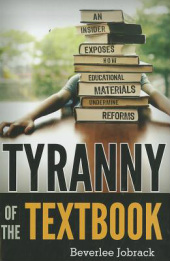(1) Textbook development: Textbooks are developed based on tradition and based on competitors’ products. No one in the publishing industry worries about whether the materials are effective. As Jobrack notes, publishers are for-profit enterprises. They need decision-makers to adopt their textbooks. Decision-makers do not base adoptions on effectiveness—or at least, publishers believe that they do not.
(2) Textbook adoption: What factors drive adoptions? To the extent that teachers have any input, it will be teacher leaders, and they already teach well. They have an existing set of lesson plans that work well. So they are not interested in a textbook that would necessitate rewriting all of those lesson plans. So new textbooks tend to be conservative. Further, just three publishing companies account for 75% of the market. So most of the books look the same. Consequently, relatively trivial features have an outsize influence on adoption decisions.
Trivial features like the cover design. Like the font size. Like whether the important features are clearly labeled or a bit more difficult to find.
Content matters to adoptions, according to Jobrack, only insofar as the publishers ensure that all of the state standards are “covered.” But she goes on to point out that there is little or no attention paid to ordering and presenting this content in a way to ensure that students learn. Again, effectiveness of learning is simply not on the publishers radar screen.
(3) Why textbooks matter: Jobrack argues that textbooks are hugely important because they constitute a de facto curriculum. Beginning teachers are overwhelmed by the prospect of writing lesson plans, and so depend heavily instructional materials provided by publishers.
Is Jobrack right about all this? She ought to know whereof she speaks. She was promoted through the editorial ranks until she was the editorial director of SRA/McGraw-Hill. Still, we should bear in mind that these are mostly Jobrack’s impressions, not a systematic study of publishing business practices.
I admit that I’m probably more ready to believe Jobrack on publishing because her description so often matches my own experience. Like the beginning teachers she describes, when I first started teaching cognitive psychology, I relied heavily on published materials. I laid out four textbooks on my desk, used the sequence of topics they all shared, and cobbled together lectures by stealing the best stuff from each.
I saw the conservatism Jobrack describes much later when I prepared to write my cognitive textbook and told my editor that I wanted to do something really different than what was currently on the market. Her response: “Okay, but don’t make it more than about 20% different or you’ll never get any adoptions.”
A point Jobrack makes indirectly but strikes me as more important than she realizes is the role of measurement. Jobrack notes that publishers would be motivated to make textbooks effective if that drove the market. Well, in order to know whether they are effective, we—teachers, administrators, parents, researchers, policymakers—need to agree on what we mean by effective and on a way to measure it. The textbook problem brings fresh urgency to this issue.
Whether Jobrack is right or not, I hope this book will prompt greater discussion about textbooks, and greater scrutiny of adoption processes.

 RSS Feed
RSS Feed